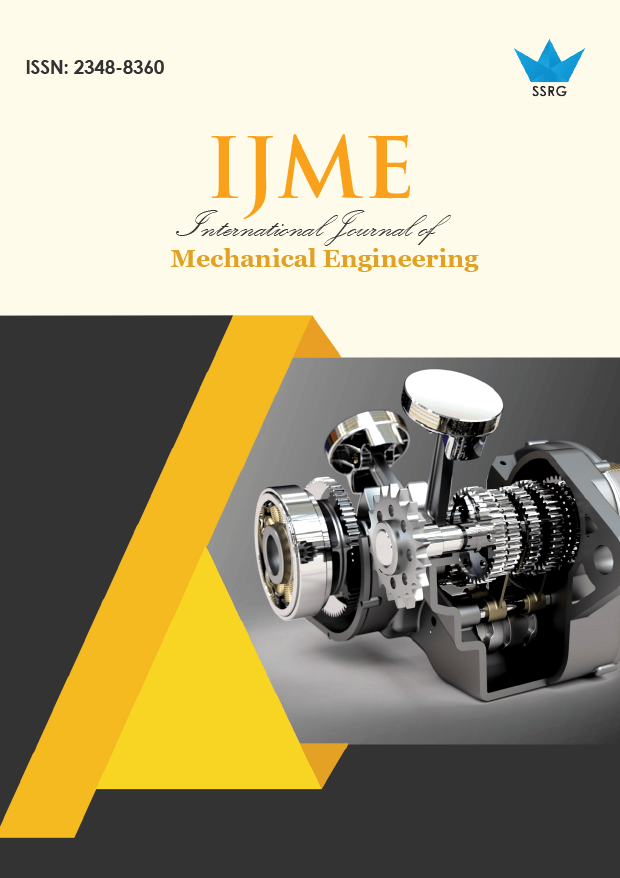Process parameters optimization for Abrasive Assisted drilling of SS316

| International Journal of Mechanical Engineering |
| © 2017 by SSRG - IJME Journal |
| Volume 4 Issue 1 |
| Year of Publication : 2017 |
| Authors : Rajender Singh, Krishan Kumar |
How to Cite?
Rajender Singh, Krishan Kumar, "Process parameters optimization for Abrasive Assisted drilling of SS316," SSRG International Journal of Mechanical Engineering, vol. 4, no. 1, pp. 29-33, 2017. Crossref, https://doi.org/10.14445/23488360/IJME-V4I1P105
Abstract:
Stainless steel 316 grade has broad applications in medical equipments. SS316 has property of corrosion resistance that provides its applications in various areas. This paper presents the optimization of process parameters (spindle speed, feed and slurry concentration) in abrasive assisted drilling. Also analysis of variance is carried out for the contribution of parameters and interaction among various factors. In present investigation we have taken Silicon Carbide as abrasive particles. Silicon carbide and water as slurry concentration by weight. SiC concentration varies from 15% to 25% are optimized using multiple performance characteristics for surface finish. This abrasive slurry concentration performs the dual function of coolant as well as cutting fluid. Feed rate and speed of spindle are most significant factors which affects the surface roughness. An overall improvement of 10% in surface finish has been obtained with abrasive assisted drilling.
Keywords:
Abrasive, Anova, Drilling, RSM, SS316, surface finish, SiC.
References:
[1]Bhatnagar, N.,Nayak,D., Singh I., Chouhan H.,& Mahajan, P. (2004).“Determination of machining induced damage characteristics of FRP composite laminates. Materials and Manufacturing Processes”, 19,1009–1023.
[2]Gaitonde, V.N.; Karnik, S.R.; Siddeswarapa, B.; Achyutha, B.T. ,“Integrating Box-Behnken design with genetic algorithm to determine the optimal parametric combination for minimizing burr size in drilling of AISI 316L stainless steel”. Int. J. Adv. Manuf. Technol. 2008, 37, 230–240.
[3]Goyal, K. K.,Jain, V., & Kumari, S. (2014). Prediction of Optimal Process Parameters for Abrasive Assisted Drilling of SS304. Procedia Materials Science, 6(Icmpc), 1572–1579. doi:10.1016/j.mspro.2014.07.139
[4]Hocheng H, Tsao CC., “Comprehensive analysis of delamination in drilling of composite materials with various drill bits”. J Mater Process Technol 2003;140: 335–9.
[5]Hocheng H and Tsao C .C. (2005), “The Path towards Delamination- Free Drilling of Composite Materials,” Journal of Material Processing Technology, 167: 251-264.
[6]Islam, M. N., Rafi, N. H., & Charoon, P. (2009). “An investigation into effect of canned cycles on drilled hole quality. In Proceedings of the world congress on engineering”, Vol IWCE 2009, July 1–3. London,U.K..
[8]Kıvak, T., Samtas, G., & Cicek, A. (2012). “Taguchi method based optimisation of drilling parameters in drilling of AISI 316 steel with PVD monolayer and multilayer coated HSS drills. Measurement”,45, 1547–1557..
[9]Kurt,M., Bagci, E.,&Kaynak, Y. (2009). “Application of Taguchi methods in the optimization of cutting parameters for surface finish and hole diameter accuracy in dry drilling processes. The International Journal of Advanced Manufacturing Technology”, 40, 458–469.
[10]Mandal, N., Doloi, B., Mondal, B., & Das, R. (2011). “Optimization of flank wear using zirconia toughened alumina (ZTA) cutting tool; Taguchi method and regression analysis. Measurement”, 44, 2149–2155.
[11]Rajmohan T. and palanikumar K., “optimization of machining parameter for surface roughness and burr height in drilling hybrid composite”. Materials and manufacturing processes,2012 27:320-328.
[12]Sahoo, P.; Barman, T.K.; Routara, B.C., “Fractal dimension modelling of surface profile and optimisation in CNC end milling using response surface method”. Int. J. Manuf. Res.
[13]Sanjay C and Jyothi. C (2006), “A Study of Surface Roughness in Drilling using Mathematical Analysis and Neural Networks,” International Journal of Advanced Manufacturing Technology, 29:846-852.
[14]Suresh, R., Basavarajappa, S., & Samuel, G. L. (2012b). “Some studies on hard turning of AISI 4340 steel using multilayer coated carbide tool”. Measurement, 45, 1872–1884.
[15]Suresh,R., Basavarajappa, S., Gaitonde,V.N.,&Samuel, G. L. (2012a). “Machinability investigations on hardened AISI 4340 steel using coated carbide insert. International Journal of Refractory Metals and Hard Materials”, 33, 75–86.

 10.14445/23488360/IJME-V4I1P105
10.14445/23488360/IJME-V4I1P105